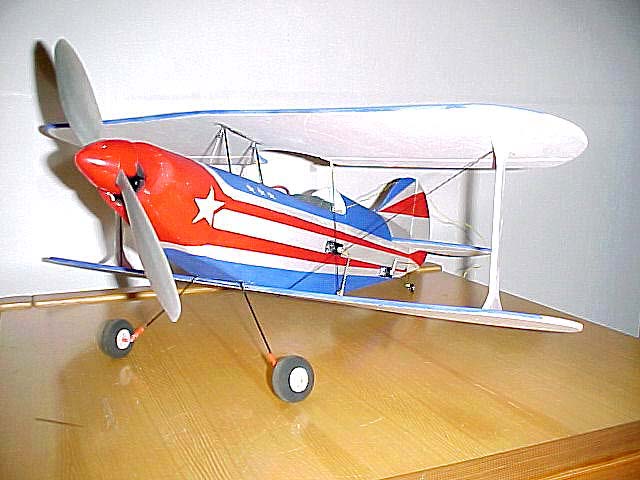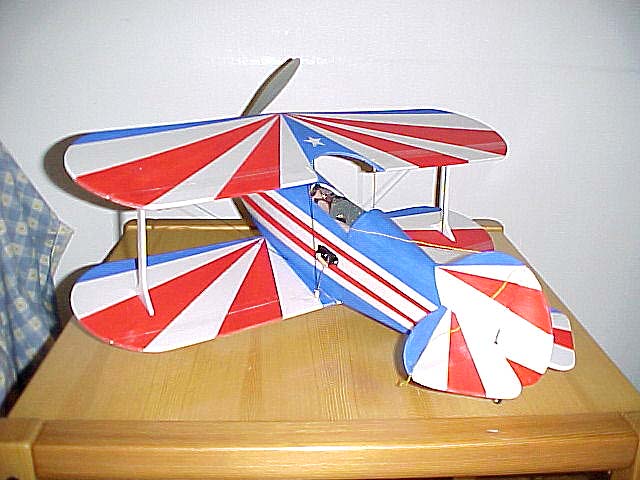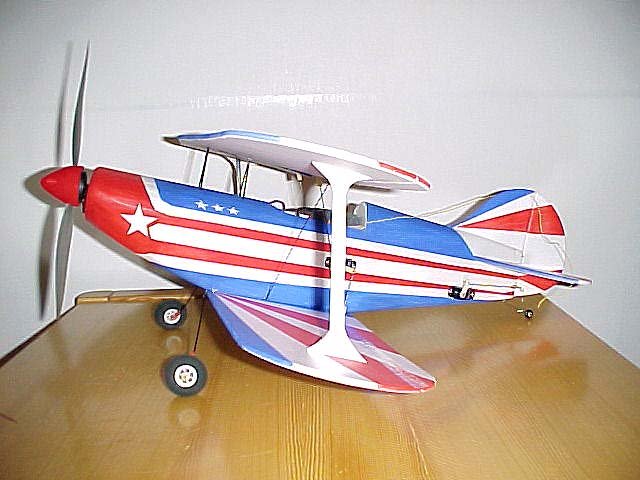Pitts Special (6/3/00)
As someone who is: 1.crazy about everything aerobatic, 2.admirer of the TOC masters, 3..father of three, 4. one who rents a 3 room flat, I decided to build something that would correspond to all the above. That means, something nearly impossible. Having seen the Klaustrofobia (German Indoor R/C Club) web pages, I decided to build a fully aerobatic Pitts Special, wingspan 550 mm, where the static pull of the (electric) engine should exceed its weight.

The original I´ve seen at Klaustrofobia was equipped with the following:
Speed 280, 1:5 gear, carbon prop 250/150, nine 110 mAh Sanyo cells. The static
pull they said was over 250 grammes. This 198 g model was capable of Torque Roll.
Since this was my first model of this kind, I realized that the weight of
my model would be higher. I wanted to fly this plane outdoors as well, therefore
opting for a slightly more robust construction. Also, standard and affordable
equipment was to be used.
The engine is Speed 280 with the prop being as large as possible, for the
maximum static pull. Using 1:5 Horst gear and the APC 250/120 prop, the static
pull of this setup exceeds 270 g. This is using 10 Sanyo cells (110 mAh) and
Schulze 08 speed control (Schulze survives this well although it is recommended
for 8 cells only). The current draw was 3 amps. The unit is capable of the
maximum pull for some 30 sec, the next 30 sec the pull is gradually going down
to some 200 g. The last 30 sec the power is sufficient for the final approach
and landing. So the plane has 90 to 120 sec of "full throttle" flight.
I believe the flight time should be longer if the pilot is easy on the throttle
stick, the flight would probably last longer than the pilot´s nerves.

The model is built fully of styrofoam and carbon sticks. In search of
suitable materials, I browsed through the OBI store looking for materials
equivalent to those used by the German builders. At the end I found 4mm fine
grain styro sheets, paper coated on one side. One pack of sheets includes twelve
165x1000mm sheets. One sheet is about 30g.
The whole Pitts is made of 3 sheets. The weight of the airframe is some 60 g, some 75g after an acrylic paint, adding of landing gear and some reinforcements. The model, ready to fly, is some 270g. It would be possible to build lighter, using airbrush instead of the paintbrush, styro CA istead of epoxy, not install the spinner (20g), use 3 servos instead of 4, make the electric installation ligter (thinner cables, no connectors) etc. I believe that 200 g is realistic. The styrofoam I used is quite resilient, doesn´t need any coating (just the paint if you wish) and is easy to cut with a sharp knife.

I attempted to test-fly the model in a gymnasium, into which I was invited by one long time slow flyer Jarda Chadim. Unfortunately the size of the gym did not correspond to the needs of the model. After some 5 meters the model took off, climbed under a 45° angle to the opposite corner of the gym where I turned the model 180 degrees, idled the throttle, made a hair-rising descent and a crash-landing on the spot from which I started. After calming down my shaking knees, I made few more similar attempts. After hitting the head of another pilot I decided to quit. I only tested one more thing: the ability of the model to hover, where one of my friends held it in a nose-up position and released it for a second. The plane was able to hover just like a helicopter. This would allow endless verticals, if only the model was a little bit lighter.
I am getting ready for an outdoor test-flight, waiting for the weather to improve. I hope that I will be able to share my experience with the readers of RC Mania.
I
used:
4 servos HS50
Receiver REX 4, modified to 5-channel
10x Sanyo 110 mAh
Speed Control Schultze 08
Motor Speed 280
Gear Horst 5:1
Prop APC 250/120